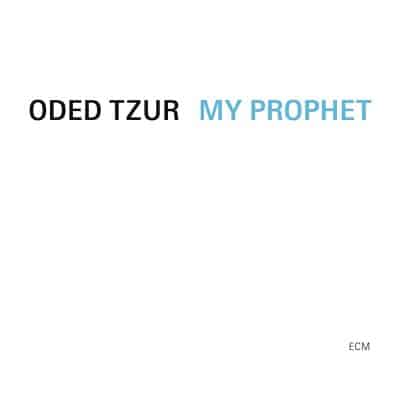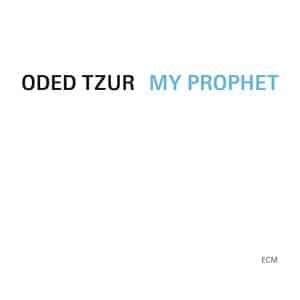Oded Tzur My Prophet
 Oded Tzur
Oded Tzur
My Prophet
ECM
It’s long been said that some of the greatest saxophonists such as Charlie Parker, John Coltrane, Sonny Rollins, and Coleman Hawkins are easily identifiable in just the first few notes they play. While we’re not yet putting the Israeli-born and raised New York City based saxophonist Oded Tzur in that ‘all-time great’ category, he too certainly has a unique sound. His tenor saxophone’s soft tones often sound like a flute, and at times belie the spiritual intensity of his approach. Tzur issues his fifth album and third for the ECM label with The Prophet, his follow-up to Isabela, which we covered here. Tzur’s sound marries Indian Classical music with jazz. As a disciple of Hariprasad Chaurasia, a primary educator of that music at the Rotterdam World Music Academy, Tzur developed a saxophone technique that extends the instrument’s microtonal capacity, inspired by Chaurasia’s bansuri playing and other Indian instruments, which he named Middle Path. The technique enables the saxophone to slide between the notes and highlight specific microtones, thereby differentiating it from traditional saxophone playing. Chaurasia once described it by saying: “If a curtain were to be drawn in front of him, no one could tell which instrument was being played.”
Once again joining Tzur are longtime collaborators pianist Nitai Hershkovits, bassist Petros Klampanis with new member, drummer Cyrano Almeida. Often the sound can be meditative, ruminative, and folk-like but here there are passages that may well represent Tzur’s fiercest attacks as well. Again, there are no real reference points except for Tzur’s previous work. The interplay is remarkably tight as the group, except Almeida, has been together for seven years now and has reached an even higher level of improvisational freedom here. Tzur is set on developing and reprising the heads of his songs but what happens in between is up to the individual voices. Pianist Hershkovits is especially expressive and unpredictable, fusing jazz, classical, and undefinable elements. As much as Tzur has a unique tenor sound, the group sound is defined mostly by this interplay between Tzur and the pianist. Almeida infuses their collective sound with a new kind of energy, giving these four-way conversations a different bent than the previous two ECM releases. He grew up in the African-Brazilian Candomblé religion and brings his own pulse to the music.
After the calm solo statement, “Epilogue,” “Child You” begins with the band in unison before Tzur takes his extended excursion, fille with shifting dynamics and soft clusters, prayer-like at times with increased intensity as he builds it. Hershkovits moves deliberately at first and then mixes energetic passages with pensive ones in an intimate dialogue with his rhythm mates that evolves into a fascinating rapid fire four-way conversation. Tzur reprises the theme and brings a definitive resolution to the close. “Through a Land Unsown” is a feature for the earthy tones of bassist Klampanis who leads the ensemble through a melancholy blues-tinged but mysterious exploration that seems relatively simple in comparison to other pieces. The pianist takes the next turn, chords mixed with glimmering scalar runs. Tzur waits patiently, entering at the seven-minute mark, effectively reflecting the theme established by the bassist while twisting it, embellishing it, and delivering his customary ‘fire and rain’ approach, the pianist accenting the latter as they quietly exit.
The next two pieces are truly meditative. “Renata” has a gentle ebb and flow marked by Almeida’s subtle brush work and Tzur’s restrained, softer tones while playing what resemble an Indian raga. The rhythm section pushes him and quartet crescendos sharply before a pause that leads to a contemplative turn from the pianist, infusing his improvisation with short bursts of the theme, by turns nimble and commanding. The group again exits in a whisper. The title begins much the same way, Tzur sounding flute-like upon entry. The unhurried approach beckons the use of space as a ‘fifth’ member, with Hershkovits laying down a trance-like, mesmerizing solo, the sonic equivalent of an impressionistic painting. Tzur weaves gently, exhibiting his trademark quiet intensity, punctuated by a few bass strokes and carefully placed piano notes, in utmost fervency, the last note just lingering in the ether.
The closing “Last Bike Ride in Paris” (great title) is a complete departure with the group swinging and rollicking such that toward the end Tzur’s attack is indeed fierce, and Coltrane-esque. It’s a frenetic, unencumbered release of exuberance following the restraint of the previous two. Like Isabela, the brevity of the album works in Tzur’s favor, increasing the odds of hitting “repeat,’ especially with the album ending on such a high note. This is special music, meticulously crafted but allowing enough room for colorful improvisation and freedom within the compositions. Tzur continues to stand apart.
- Jim Hynes
BUY NOW
Buy Us a Cup of Coffee!
Join the movement in supporting Making a Scene, the premier independent resource for both emerging musicians and the dedicated fans who champion them.
We showcase this vibrant community that celebrates the raw talent and creative spirit driving the music industry forward. From insightful articles and in-depth interviews to exclusive content and insider tips, Making a Scene empowers artists to thrive and fans to discover their next favorite sound.
Together, let’s amplify the voices of independent musicians and forge unforgettable connections through the power of music
Make a one-time donation
Make a monthly donation
Make a yearly donation
Buy us a cup of Coffee!
Or enter a custom amount
Your contribution is appreciated.
Your contribution is appreciated.
Your contribution is appreciated.
DonateDonate monthlyDonate yearlyYou can donate directly through Paypal!
Subscribe to Our Newsletter
Discover more from Making A Scene!
Subscribe to get the latest posts sent to your email.














































